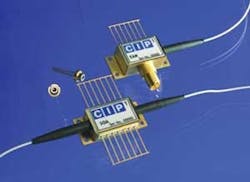By Meghan Fuller Hanna
Overview
Long-awaited applications that leverage the specific strength of the SOA had finally started to emerge when the economy turned sour. Undeterred, SOA manufacturers insist the device is still poised to become the transistor of the all-optical network.
A semiconductor optical amplifier (SOA) can be used much like an erbium-doped fiber amplifier (EDFA) for a number of applications, including as a post-amplifier after a transmitter, as a preamplifier before a receiver, as an amplifier somewhere within the fiber link, or as a line amplifier simply to provide gain in a transmission system. SOA manufacturers once hoped that SOAs would compete head-to-head with EDFAs, but this scenario no longer appears likely.
Meanwhile, new applications that leverage the specific strength of the SOA began to emerge. The sweet spot for SOAs is outside the erbium fiber window, which typically encompasses just the C-band. Unlike the EDFA, SOAs can support wavelengths from 1,060 nm (used solely for medical applications) to 1,600 nm, making them ideal for use across access, metro, and long-haul networks. But the handful of SOA manufacturers left in the market, including Alphion (www.alphion.com), Amphotonix (www.amphotonix.com), CIP Technologies (www.ciphotonics.com), InPhenix (www.inphenix.com), and Thorlabs Quantum Electronics (www.thorlabs.com), have seen many of these applications delayed by the economic uncertainty of today’s market.
The application that has seen perhaps the greatest deployment of SOAs is one in which the device holds a wavelength advantage over EDFAs: GPON extension. Shorter distances of, say, 20 km and a split ratio of 32 optical network terminals (ONTs) can be achieved without amplification or extension technology. But if you were to take GPON to its logical limit—60 km and 128 ONTs—you would need to increase your power budget, explains Chris Peterson, vice president of marketing at Alphion. And you have to consider the power budget in the downstream (1,490 nm) and upstream (1,390 nm), both of which fall outside the EDFA window. Furthermore, the upstream traffic presents a secondary problem: When those 128 ONTs are transmitting back to the centralized optical line terminal (OLT), that traffic is very bursty. Fiber amplifiers do not like bursty traffic, but SOAs can handle it with relative ease, Peterson notes.
The SOA’s ability to support bursty traffic makes it ideal for use in packet-based metro Ethernet networks as well. EDFAs like to operate in saturation, especially in an environment with constant average power, as in a SONET/SDH network. But in bursty traffic, EDFAs require sophisticated gain control circuits, or they must be operated in the linear mode. In this case, says Peter Heim, chief technology officer of Thorlabs Quantum Electronics, SOAs start to look very competitive. Thorlabs is currently supplying a limited number of SOAs to network providers for greenfield, packet-based networks.
“It’s still not huge,” Heim admits, “but it’s definitely an emerging application for us. I think the economic situation has pushed a lot of this stuff out.”
SOAs may also find a home in the long haul, particularly if carriers choose to adopt the OIF-sanctioned 10-Gbps transmission based on polarization multiplexing with coherent detection. According to Heim, Thorlabs Quantum Electronics specializes in polarization-insensitive SOAs, which the company calls Booster Optical Amplifiers (BOAs). “We’re working with all the major system providers on those sort of systems, using the BOA on the receive path,” says Heim.
The promise of WDM-PON
Conservative spending by today’s carriers appears to have pushed out the one application that could have provided SOAs with significant volumes: WDM-PON. In this case, a reflective SOA (RSOA) is used as a modulator. It is attractive for WDM-PON because it is both reflective and provides gain. As David Smith, chief technology officer of CIP Technologies, explains, an RSOA would be used in each of the ONTs or home units.
In the WDM-PON application, a centralized node or OLT generates a range of wavelengths that are transmitted into the network to a wavelength-selective element, typically an arrayed waveguide grating (AWG). Light travels from the AWG to an RSOA in each ONT. “And that reflective SOA would take the light that comes from the centralized source, take the wavelength that’s been selected by the filter in the network, and reflect it back,” says Smith. “By modulating that [light], switching the SOA on and off with the data signal at the terminal, you could effectively act as a WDM-type transmitter. And it’s colorless. It doesn’t generate a wavelength; it takes a wavelength in, modulates it, and reflects it back.”
The RSOA is ideal for WDM-PON because it eliminates the need to deploy a transceiver at every ONT, a cost-prohibitive proposition. That said, the current economic climate may render WDM-PON too costly, with or without the RSOA. “The problem with WDM-PON is that it offers more than people really need right now,” muses Heim. “So how do you price that? How do you find a way to phase that in so it makes any kind of sense for the Verizons of the world?”
To further lower the costs, several manufacturers are attempting to develop an uncooled RSOA; today’s RSOAs must be cooled or semicooled to achieve the requisite performance parameters, and that cooler results in higher cost and increased power consumption. Heim calls this “the biggest technical issue” for RSOAs. “People have shown pretty good performance from 0° to 50°C, but to really get that extra 10° to 15°C, it’s tough,” he admits. “There are some fundamental physics—the bandgap changes with temperature, so the wavelengths shift. There’s nothing you can do about that.”
That said, Heim believes RSOAs are “definitely better” than the alternative, injection-locked Fabry-Perot lasers. Heim confirms that Thorlabs Quantum Electronics “has put a lot of effort into this.” CIP and Amphotonix currently offer RSOA devices.
But not every SOA manufacturer sees opportunity in the WDM-PON market. “We’ve looked at it pretty hard,” says Alphion’s Peterson, “but it’s unclear whether reflective SOAs make a lot of sense [for WDM-PON applications].” Where they do make sense, he says, is for emerging 10G EPON. An increase in the data rate from 1 Gbps to 10 Gbps causes a significant reduction in receiver sensitivity. Peterson reports “tremendous interest,” particularly in the Far East, in embedding SOAs in the receiver to increase the power budget in front of the 10G signal. “We are talking to people,” he confirms.
Looking ahead
Several recent trends may help the SOA to become more cost effective in the future. Today, photonic integrated circuits (PICs) and silicon photonics are leading the way toward monolithically integrated devices, and the SOA appears to hold a competitive advantage over the EDFA in this arena. SOAs can be more easily integrated with other components.
This integration can occur in one of two ways: SOAs can be integrated monolithically or they can be used in hybrid ICs with other materials. “You can use indium phosphide SOA devices as the active component,” says CIP’s Smith, “and you can use silica on silicon to make the passive components, the couplers, splitters, filters, and waveguide devices.”
The SOAs themselves are likely to migrate to array-based devices in the future, notes Heim. Thorlabs Quantum Electronics comprises the former Covega Technologies, which Heim claims is the largest provider of discrete SOAs for telecom applications, supplying thousands of units currently carrying live traffic. Even he admits the future of telecom is not in discrete SOAs but in arrays. In the standard, standalone SOA, most of the cost is in the packaging. If you could put four SOAs inside a single butterfly, you would effectively reduce the cost by a factor of four. In fact, he says, “discrete, butterfly-package, single-element devices have never really taken off and might not ever. But I do think arrays of them definitely will because you can get the cost down.”
In terms of future applications, SOA manufacturers believe the technology will be most useful for nonlinear processing, like wavelength conversion, multiplexing/demultiplexing, and high-speed optical switching. SOAs can be turned on and off very rapidly, usually within nanoseconds or less.
“That’s one to watch for the longer term,” says Smith. “You are not going to see immediate commercial use of SOAs for ultrafast optical switching, but a large number of research labs around the world are buying them [today].”
For his part, Smith believes the SOA may one day be as ubiquitous as the transistor. “You can actually optimize these things for all sorts of applications, either as modulators in WDM-PON, as gain blocks for tunable external-cavity lasers, as line amplifiers, preamplifiers, post-amplifiers, switches. It’s like the transistor, a universal building block that can be adjusted and designed to suit different applications.”
“The all-optical processors are going to be SOA-based,” agrees Heim. “The SOA is essentially going to be the transistor for that sort of thing, but that’s still 10 years away.”
Meghan Fuller Hanna is senior editor at Lightwave.
One-CLICK LINKS
LIGHTWAVE:SOAs Still Awaiting Big Chance
LIGHTWAVE: SOA Debate Rages On
LIGHTWAVE: Worldwide Consumption of SOAs to Reach 240k Units


